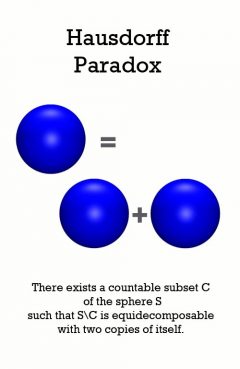Hausdorff Paradox

Release Date: //1914
Country of Release:
Length:
MPAA:
Medium: Paradox
Genre:
Release Message: There exists a countable subset C of the sphere S such that S divided by C is equidecomposable with two copies of itself. Authored by Felix Hausdorff.
Description: In mathematics, the Hausdorff paradox, named after Felix Hausdorff, states that if you remove a certain countable subset of the sphere S2, the remainder can be divided into three disjoint subsets A, B and C such that A, B, C and B -C are all congruent. In particular, it follows that on S2 there is no finitely additive measure defined on all subsets such that the measure of congruent sets is equal (because this would imply that the measure of A is both 1/3 and 1/2 of the non-zero measure of the whole sphere). The paradox was published in Mathematische Annalen in 1914 and also in Hausdorff's book, Grundz_ge der Mengenlehre, the same year. The proof of the much more famous Banach-Tarski paradox uses Hausdorff's ideas. This paradox shows that there is no finitely additive measure on a sphere defined on all subsets which is equal on congruent pieces. (Hausdorff first showed in the same paper the easier result that there is no countably additive measure defined on all subsets.) The structure of the group of rotations on the sphere plays a crucial role here - the statement is not true on the plane or the line. In fact, as was later shown by Banach,[1] it is possible to define an "area" for all bounded subsets in the Euclidean plane (as well as "length" on the real line) such that congruent sets will have equal "area". (This Banach measure, however, is only finitely additive, so it is not a measure in the full sense, but it equals the Lebesgue measure on sets for which the latter exists.) This implies that if two open subsets of the plane (or the real line) are equi-decomposable then they have equal area.